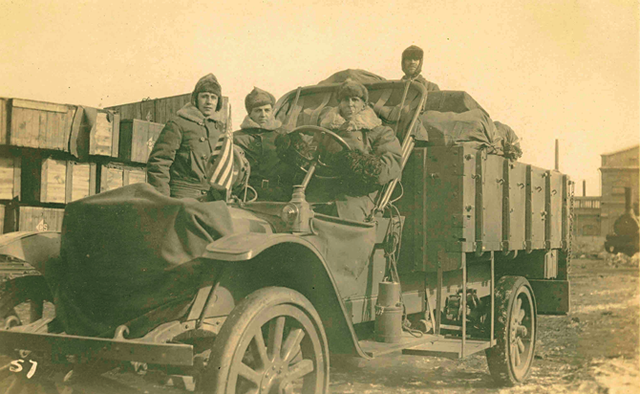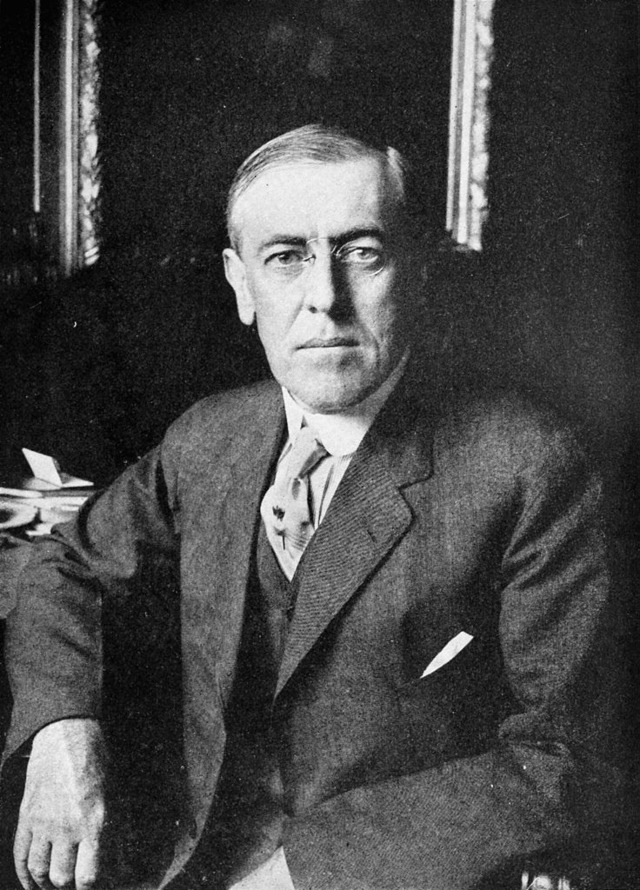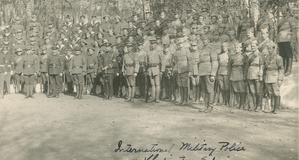Featured Article:Woodrow Wilson and the American Expeditionary Force to Siberia, 1918-1920
By
2014, Vol. 6 No. 04 | pg. 1/2 | »
KEYWORDS:
On August 15, 1918, American doughboys landed in Siberia to begin one of the more contentious episodes in U.S.-Soviet relations. The over seven thousand troops of the American Expeditionary Force were to remain for more than eighteen months, playing a rather forgotten role in the Russian Civil War. Historians have since tried to understand the motives behind President Woodrow Wilson’s decision to dispatch U.S. troops to the region. Wilson, as usual, never plainly stated his intentions but cloaked them instead in the eloquent rhetoric that became his hallmark. Several explanations of Wilson’s actions have since emerged.1 Two interpretations see intervention as part of the Allied war effort, with the President portrayed as believing claims that the Bolsheviks were actually German Agents, or as acting in a way to steer his allies into supporting Russian ‘liberal nationalism’ against the threats of both Russian Bolshevism and German militarism.2 A third interpretation, offered by the former diplomat George Kennan, explains the dispatch of troops ultimately as an effort to rescue the beleaguered “Czech Legion,” which had just captured the port of Vladivostok (the future base of operations for Allied Intervention) and who were at the time of the U.S. landing eagerly pursuing the Red Guard into the Siberian wilderness.3 Perhaps the most pervasive interpretation, however, places the onus for U.S. troops in Siberia onto the emerging empire of Japan.4 By sending troops to Siberia at a time when Allied intervention appeared inevitable, the President had hoped to restrain Japanese expansion and thereby preserve the “Open Door” in the Far East. The Japanese responded to Wilson’s action by sending ten times the number of troops called for by the U.S. President, and proceeded to establish themselves at strategic locations along the Trans-Siberian Railway. The historian John White saw the U.S. military expedition as “a forceful reminder of the American desire” to prevent further Japanese expansion.5 An expeditionary force that was outnumbered ten to one, vastly out-gunned in artillery, and suffering an eight thousand mile supply line stretching across the Pacific Ocean to San Francisco may have appeared more as a reminder of Wilson’s difficult position. The fact that American troops worked with the Japanese (despite the mutual and often violent dislike) in achieving a common objective has never been addressed adequately by White, nor any other historian researching the July 6, 1918 decision to intervene.The actual military record of the American Expeditionary Force is extremely useful in understanding that decision, and can be seen as supporting yet another interpretation. To William Appleman Williams the President was decidedly anti-Bolshevik and the primary purpose for intervention was to counter-revolution. “Intervention as a consciously anti-Bolshevik operation was decided upon by American leaders within five weeks of the day Lenin and Trotsky took power”.6 The were no illusions about the threat posed by the Bolsheviks. They were social revolutionaries, as U.S. leaders acknowledged, albeit in private. Their view of socialism and Bolshevism was accordingly accompanied by antagonistic policies, firstly through recognition of counter-revolutionary leaders. Other measures included funding of British and French sponsored campaigns against the Bolsheviks, channeling aid to the ‘White’ armies forming in Siberia and South Russia, unofficial participation in blockades designed to starve out Communist held regions (and manipulating relief programs to the same end) and clandestinely using the Russian Embassy in Washington’s resources to further support counter revolutionary efforts.7 In the reality of war in Siberia and within the limitations of domestic politics, the AEF was used as another measure in the campaign to topple the government in Moscow. Rather than the culmination of American policy in Russia, the dispatch of the American Expeditionary Force was a natural extension. Wilson’s pragmatic wait-and-see policy allowed him (and his expeditionary force) to exit Siberia when all hope of successful counterrevolution had vanished. Rather than idealistic or misguided, Wilson’s Siberian policy allowed the President to cautiously play the situation with a minimum political and military cost. Throughout the winter and spring of 1918 Wilson watched a succession of White leaders emerge to fight the Bolsheviks. The policy of supporting “reputable and sound elements of order” (the chief euphemism for anti-Bolshevik forces)8 continued in its many forms.9 The President was extremely cautious, however, in making any definite military commitment. He was not willing to back any horse until it was definite winner. That such a sure thing never arose during the entire period of intervention was a feature of the civil war that Wilson was to adapt to. It is clear that the President had good reasons for his caution and worked within numerous constraints. The war in Europe took precedent in any military planning. Any “line of action through Russia” against Germany was, furthermore, discounted by the Army War College. The issue, the College concluded, “will be settled on the Western Front”.10 Domestically, Wilson had his priorities. Always with an eye on the post-war settlement in Europe, he could not afford to alienate the Republican controlled Congress with a dubious Russian policy. It was the Republicans, after all, who had the final over his plans for a “new world order” represented by a League of Nations. The President had to be flexible in policy implementation despite being inflexible and deterministic in policy objectives. Any military option, if required, would therefore have to support counter-revolution whilst simultaneously appearing impartial and not bring a storm of indignation at home. The official reasons for U.S. intervention, as announced in an Aide-Memoire of July 17, 191811, would, for a time, fulfill those criteria. The so-called ‘Czech Legion’ ultimately provided Wilson with the justification for intervention. During the early months of the First World War an army of Czechs and Slovaks was formed to fight alongside the Russians against the Austro-Hungarian Empire. Despite sanctioning its formation, Czar Nicholas II deeply distrusted the Legion and refused to allow it to fight with his troops. The Bolsheviks, after their seizure of power, also uncomfortably viewed the Legion as a foreign army on their soil. Indeed, the Czechs were one of the only disciplined and cohesive fighting forces in Russia at the time, numbering almost seventy thousand. Finding themselves after the Treaty of Brest-Litovsk, which ended the war between Russia and Germany, as an army without a war, agreements were reached between the Czechs and Bolsheviks whereby the Legion could exit Russia via the Trans-Siberian Railway. The Legion would embark at Vladivostok for France to continue the fight for national independence. None were to complete the trip during the war. In May at the town of Chelyabinsk the agreement broke down.12 What began as a clash between Czech echelons moving east and Austro-Hungarian prisoners-of-war being repatriated under the Treaty of Brest-Litovsk moving west resulted in open warfare between the Bolsheviks and the Czechs. The Bolsheviks demanded the Czechs surrender their weapons for passage out of Russia. The Czechs quite naturally refused, and the conflict quickly spread the length of the five thousand mile long railway, over which detachments of the Legion were strewn. After receiving news of the uprising President Wilson informed his allies that he was rethinking the situation. During early June news came that the Czechs had captured Vladivostok and the President made up his mind. With Vladivostok under ‘friendly’ control, the Allies possessed a secure base of operations. As the eastern terminus of the Trans-Siberian Railway, Vladivostok was the key to launching and supplying any military effort. Ahead lay thousands of miles of track, running westward across Manchuria, and north to Khabvorosk, then also turning west into the Siberian hinterland, leading ultimately to Moscow. It was the supply line built by the last Czar to expand his empire, and it was now the lifeline of the counterrevolution struggling to get back to the center. Indeed, it was the jugular vein of Siberia. Any hope of determining the outcome of the civil war in eastern Russia depended upon controlling and keeping open that railway system. The Czechs, in one sense, were just the type of force Wilson sought to support in Siberia. They were anti-Bolshevik, anti-German, and anti-Japanese. They were the most effective fighting force at the time in Siberia through which to support counterrevolution. Wilson took the opportunity “to help the Czechoslovaks consolidate their forces and get into successful cooperation with their Slavic kinsmen,” as the Aide-Memoire announced. Left undefined was who exactly their Slavic kin were. The memoire was equally vague in other areas. The AEF was “to steady any efforts at self-government or self-defense in which the Russians themselves may be willing to accept assistance,” and also to guard the vast amount of military supplies that had built up in and around Vladivostok during the war, “which may subsequently be needed by Russian forces in the organization of their own self-defense”.13 Which Russians Wilson had in mind was likewise left undefined.Continued on Next Page » Suggested Reading from Inquiries Journal
Inquiries Journal provides undergraduate and graduate students around the world a platform for the wide dissemination of academic work over a range of core disciplines. Representing the work of students from hundreds of institutions around the globe, Inquiries Journal's large database of academic articles is completely free. Learn more | Blog | Submit Latest in History |




















